





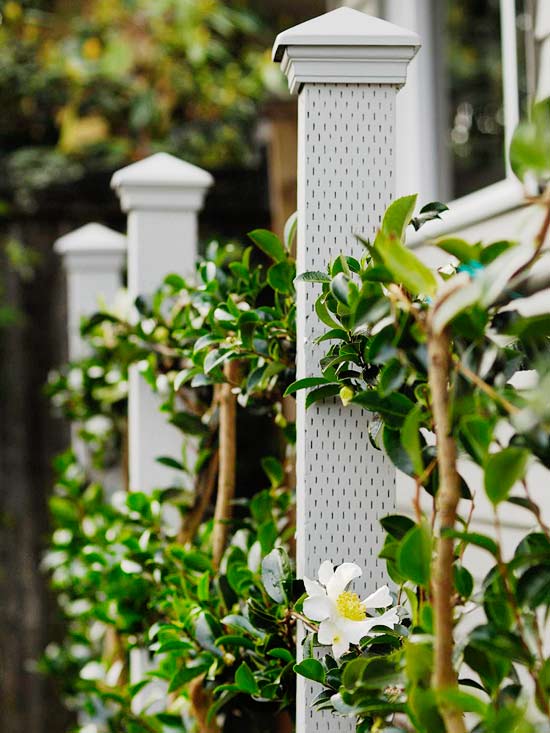
Using standard pruning techniques, you can train dwarf fruit trees to form a living wall that will enhance your yard's privacy and provide beauty and fresh produce. In an espalier (pronounced es-PAL-yay), plants grow along a usually flat, symmetrical framework against a wall, trellis, or freestanding support. Frequent pruning and tying of new growth directs the plants into a decorative pattern such as intersecting diamonds, or horizontal arms or elbows.
Related article: Espaliers for a Wall
continue reading below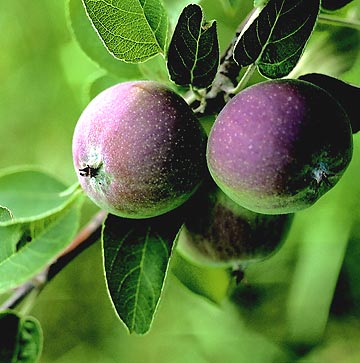 Select fruits that are disease-resistant, like this 'Jonafree'dwarf apple.
Select fruits that are disease-resistant, like this 'Jonafree'dwarf apple.
Plan your espalier to meet your needs. If you want fruit, select a dwarf apple, peach, or pear that is rock-solid hardy in your area. For a purely ornamental fence, choose a blooming tree or shrub such as flowering crabapple, magnolia, or doublefile viburnum.
Although creating an espalier isn't particularly difficult, it does take time. Expect to wait three years for fruit, and plan to spend some time each year doing light pruning and training of branches.
Bamboo can be a good living fence, too. Learn how to grow it.
Related article: Details that Enhance a Courtyard
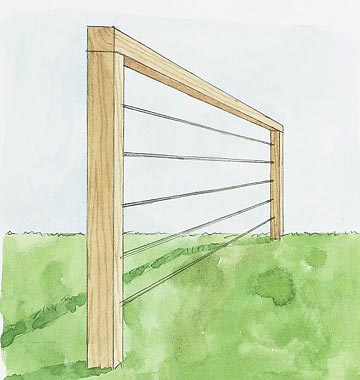
Select an overall pattern for your espalier. (For our example, we selected a diamond pattern.) Build an appropriate framework of posts (8 feet apart), a top rail, and heavy-gauge wire horizontal supports. Stretch wire tautly from post to post, spaced vertically at 1-foot intervals, to create a framework. If you train trees against a wall, leave 12 inches between the structure and the support system to allow for maintenance and air circulation. Plant 2- or 3-year-old dwarf trees at least an arm's length apart.
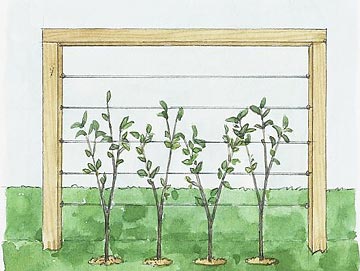
Make planting holes at least twice the diameter of the plant's root ball. Plant trees slightly in front of the wire supports. Refill the planting holes and water thoroughly. Water young trees weekly during their first summer and fall if rain is lacking. Cut off branches extending to the back or front; leave branches reaching to the sides. If you train trees along a wall, position a nail or an eye hood in the wall near intersecting branches. Loosely twist a plant tie around the branches and the hook.
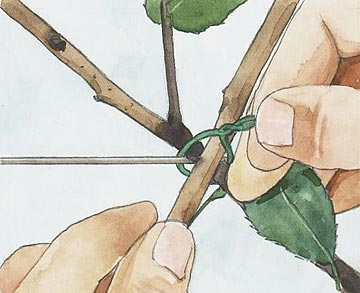
Crisscross branches from neighboring trees to train them into the desired pattern. Twist a plant tie around the branches and the wire to secure them, leaving room for branch growth. Over the next three or so years, prune and train trees in late winter. As the trees grow, continue to cross and tie the branches to the framework, snipping unwanted growth to maintain the pattern. Remove fruit buds the first two years to concentrate the tree's energy into growing branches. Look for fruit in the third year.

Select an overall pattern for your espalier. (For our example, we selected a diamond pattern.) Build an appropriate framework of posts (8 feet apart), a top rail, and heavy-gauge wire horizontal supports. Stretch wire tautly from post to post, spaced vertically at 1-foot intervals, to create a framework. If you train trees against a wall, leave 12 inches between the structure and the support system to allow for maintenance and air circulation. Plant 2- or 3-year-old dwarf trees at least an arm's length apart.

Make planting holes at least twice the diameter of the plant's root ball. Plant trees slightly in front of the wire supports. Refill the planting holes and water thoroughly. Water young trees weekly during their first summer and fall if rain is lacking. Cut off branches extending to the back or front; leave branches reaching to the sides. If you train trees along a wall, position a nail or an eye hood in the wall near intersecting branches. Loosely twist a plant tie around the branches and the hook.

Crisscross branches from neighboring trees to train them into the desired pattern. Twist a plant tie around the branches and the wire to secure them, leaving room for branch growth. Over the next three or so years, prune and train trees in late winter. As the trees grow, continue to cross and tie the branches to the framework, snipping unwanted growth to maintain the pattern. Remove fruit buds the first two years to concentrate the tree's energy into growing branches. Look for fruit in the third year.
Related article: Seven Keys to Garden Privacy
Copyright © www.100flowers.win Botanic Garden All Rights Reserved